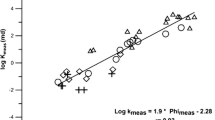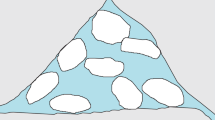Abstract
A new interpretation of the relationship between the saturation exponent (n) and the water saturation (S w ) of a reservoir rock is presented. Based on the capillary theory and Purcell equation, the relationship between resistivity index (I) and the permeability (k), water-phase permeability (k w ) has been obtained. By combining SDR model, such relationship can be transferred into a novel model of probing the saturation exponent under variable saturation conditions. Based on the theoretical derivation, NMR experimental measurements of core examples were implemented to testify the reliability brought by this development. Laboratory measurements of transverse relaxation were carried out on core samples from a formation in the Middle East. NMR experimental measurements were made with 50 samples fully water saturated. Measurements at various air/water saturation (i.e., at residual water saturation) were made on 16 samples among them obtained by different centrifuging speeds. The experimental results show that the calculated saturation exponent values and water saturations follow a power law relationship which is in accordance with researches have been published about that n is not a constant but a variable parameter dependent on water saturation, quantitatively. This study has inferred the quantitative relationship between n and S w through NMR information firstly.




Similar content being viewed by others
References
Brown GA (1988) The formation porosity exponent-the key to improved estimates of water saturation in shaly sands. In: Transactions of the SPWLA 29th Annual Logging Symposium. San Antonio, Paper AA
Carman PC (1937) Fluid flow through granular beds. Trans-Inst Chem Eng 15:150–166
Carman PC (1948) Some physical aspects of water flow in porous media. Discuss Faraday Soc 3:72–77
Carman PC (1956) Flow of gases through porous media. Butterworths Scientific Publications, London
Diederix KM (1982) Anomalous relationships between resistivity index and water saturations in the Rotliegend sandstone In: Transactions of the SPWLA 23th Annual Logging Symposium. Netherlands, Paper X
Donaldson EC, Siddiqui TK (1989) Relationship between the Archie saturation exponent and wettability. SPE Form Eval 4(3):359–362
Dunlap HF, Garrouch A, Sharma MM (1991) Effects of wettability pore geometry and stress on electrical conduction in fluid-saturated rocks. Log Anal 32(5):511–526
Helba AA, Sahimi M, Scriven LE, Davis HT (1992) Percolation theory of two-phase relative permeability. SPE Reserv Eng 7(1):123–132
Herrick DC (1988) Conductivity models pore geometry and conduction mechanisms. In: Transactions of the SPWLA 29th Annual Logging Symposium. San Antonio, Paper D
Herrick DC, Kennedy WD (1993) Electrical efficiency: a pore geometric model for the electrical properties of rocks. In: Transactions of the SPWLA 34th Annual Logging Symposium. Calgary, Paper HH
Kenyon WE (1997) Petrophysical principles of applications of NMR logging. Log Anal 38(2):21–43
Kenyon WE, Day PI, Straley C, Willemsen JF (1988) A three-part study of NMR longitudinal relaxation properties of water-saturated sandstones. SPE Form Eval 3(3):622–636
Khelil C (1971) Analysis of errors in logging parameters and their effects on calculating water saturation. In: Transactions of the SPWLA 12th Annual Logging Symposium. Dallas, Paper A
Kozeny J (1927) Über kapillare Leitung des Wassers im Boden:(Aufstieg, Versickerung und Anwendung auf die Bewässerung). Akad Wiss Wien 136a:271–306
Kumar M, Senden TJ, Sheppard AP, Arns CH, Knackstedt MA (2011) Probing the Archie’s exponent under variable saturation conditions. Petrophysics 52(2):124–134
Küntz M, Mareschal JC, Lavallée P (2000) Numerical estimation of electrical conductivity in saturated porous media with a 2-D lattice gas. Geophysics 65(3):766–772
Liu XJ, Zhou GY, Cheng J, Dai CP (2007) Study on pore structure of tight sand based on resistivity. Nat Gas Ind 27(1):41–43
Pape H, Clauser C, Iffland J (1999) Permeability prediction based on fractal pore-space geometry. Geophysics 64(5):1447–1460
Purcell WR (1949) Capillary pressures-their measurement using mercury and the calculation of permeability therefrom. J Petrol Technol 1(2):39–48
Salem HS (1994) The electric and hydraulic anisotropic behavior of the Jeanne d’Arc basin reservoirs. J Petrol Sci Eng 12(1):49–66
Straley C, Morriss CF, Kenyon WE (1991) NMR in partially saturated rocks: laboratory insights on free fluid index and comparison with borehole logs. In: Transactions of the SPWLA 32nd Annual Logging Symposium. Midland, Paper CC
Suman RJ, Knight RJ (1997) Effects of pore structure and wettability on the electrical resistivity of partially saturated rocks—a network study. Geophysics 62(4):1151–1162
Swanson BF (1985) Microporosity in reservoir rocks-its measurement and influence on electrical resistivity. In: Transactions of the SPWLA 26th Annual Logging Symposium. Dallas, Paper F
Tao G, Yue WZ, Li BT, Fang CL (2004) Electrical transport properties of fluids saturated porous rocks by 2D lattice gas automata. In: Transactions of SPE Asia Pacific Oil and Gas Conference and Exhibition. Pert, Paper SPE 88535
Wang YM, Sharma MM (1988) A network model for the resistivity behavior of partially saturated rocks. In: Transactions of the SPWLA 29th Annual Logging Symposium. San Antonio, Paper G
Wang L, Mao ZQ, Shi YJ, Cheng YM, Song Y (2014) A novel model of predicting Archie’s cementation factor from nuclear magnetic resonance (NMR) logs in low permeability reservoirs. J Earth Sci 25(1):183–188
Worthington PF, Pallatt N, Toussaint-Jackson JE (1989) Influence of microporosity on the evaluation of hydrocarbon saturation. SPE Form Eval 4(2):203–209
Yue WZ (2003) Studies on electrical transport properties of porous media and fluid saturation by 2D lattice gas automation. PhD thesis, China University of Petroleum, Beijing, China
Acknowledgments
This study was supported by the National Science and Technology Major Project of China (Grant No. 2011ZX05031) (Key Technology of Exploration and Development of Large Projects of Oil & Gas Rich Fields in the Middle East and Central Asia). The authors also would like to thank the reviewers and editors for their attention and valuable comments to improve the manuscript quality.
Author information
Authors and Affiliations
Corresponding author
Rights and permissions
About this article
Cite this article
Huang, D., Sima, L., Wu, F. et al. Estimating saturation exponent from NMR logging. Arab J Geosci 8, 6771–6778 (2015). https://doi.org/10.1007/s12517-014-1768-1
Received:
Accepted:
Published:
Issue Date:
DOI: https://doi.org/10.1007/s12517-014-1768-1




